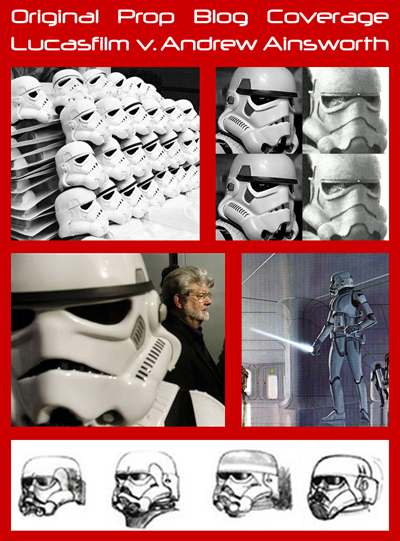Hugo Cox of The 1709 Blog, “dedicated to all things copyright, warts and all“, published a substantive feature today entitled “Star Wars: the Hearing”. This article provides coverage of the three-day UK Supreme Court hearing that took place last week, with in person observations and legal insights, analysis, and observations on Lucasfilm vs. Ainsworth in the related copyright dispute over the Stormtrooper helmets as seen in Star Wars: A New Hope.
For those interested in the proceedings, I highly recommend reading the article in its entirety at the1709blog.blogspot.com:
The article provides insights into the proceedings last week, framed by the issues to be considered by the five justices, with a ruling expected in the next few months.
Following years of legal disputes over several jurisdictions, the copyright battle has, in part, come down to the definitions and determinations of what constitutes “sculpture”.
An excerpt from The 1709 Blog analysis:
Jonathan Sumption QC for Lucasfilm argued that the helmets attract copyright as ‘sculptures’ because (a) sculptures should be defined as three-dimensional works that are created for a predominantly artistic rather than functional purpose, (b) an artistic purpose means that of creating a visual impact and (c) the helmets fall within this definition because their purpose is entirely visual not utilitarian.
Alastair Wilson QC for Andrew Ainsworth said a sculpture would be something of overwhelmingly visual significance (but not, I think, that every object of overwhelmingly visual significance would be a sculpture).
Lucasfilm’s definition of sculpture got the five justices of the Supreme Court thinking.
Author Hugo Cox characterized the splitting of hairs over varying interpretations of sculpture and “originality” as tortuous, delving into characterizations of “utilitarian” and how this would or would not apply to the faux utility of a prop or costume made for a movie, not made for actual use of its intended function in real life.
Also discussed was drawing distinctions from varying kinds of “visual impact” of sculpture, which would lead to “contemplation”.
Another excerpt from The 1709 Blog:
In the rather poor acoustics of the court I heard Wilson say that the Tin Man in the Wizard of Oz was probably a work of artistic craftsmanship and he could conceive of costumes so far removed from reality that they were sculpture. The distinctions were starting to become too subtle for some of the justices. ‘You can’t really distinguish between the Straw Man and the Tin Man?!’ Lady Hale exclaimed in disbelief.
How does the criterion of non-functionality to define sculpture fit in the context of other intellectual property rights?
Cox further notes that “[i] is not the job of the Supreme Court to rewrite acts of Parliament on the basis that they are not underpinned by sound policy” and that The Copyright Designs and Patents Act limits copyright protection to three-dimensional objects only if they fall into one of three categories:
- they are sculptures,
- they are works of artistic craftsmanship, or
- they are works of architecture
More…
Non-functional three-dimensional works of the highest artistic quality will not have copyright if they do not fall into one of these three categories.
So what is a ‘sculpture’? Wilson argued that a sculptor must have the intention to make a work of art.
In further evaluating the legal underpinnings in UK law as to the definition of sculpture, including “the meaning which that word has to ordinary members of the public“, and the Oxford English Dictionary meaning, Cox concludes “[a]lthough the helmets contribute to the aesthetic of the film and communicate a sense of menace, it would seem unlikely that they were intended as works of art in their own right“, though he leaves open the possibility that they are “works of artistic craftsmanship“. Cox says that “[c]ase law has left it as a fuzzy concept and one into which the helmets could plausibly fall“.
The second major consideration facing the UK Supreme Court is the question of jurisdiction.
Cox cites case law about a land dispute – British South Africa v Companhia de Moçambique [1893] – and discusses how it does and does not relate to the Lucasfilm v Ainsworth case, and the $20M judgment against Ainsworth in the U.S. case which preceded the UK-based proceedings.
One of the most interesting statements about the hearing shared in this article is the following, leading into the closing:
Lord Phillips noted the undesirability of leaving someone without a remedy. Unless the Supreme Court reverses some part of the Court of Appeal’s decision, Lucasfilm, whose US copyright has been held to be infringed, will be without a remedy. Apart from infringement of UK copyright and the English court hearing the claim of infringement of US copyright, there was a third alternative: enforcing the US judgment. Lucasfilm have not appealed this but from a pragmatic perspective it would have been the simplest way of providing them with a remedy. Why was it not available? Andrew Ainsworth never submitted to the jurisdiction of the US court. This reason for refusing to enforce a foreign judgment was explained in Rubin v Eurofinance:
‘It is, and has for centuries been, a fundamental principle of English private international law that the judgment of a foreign court is not enforceable unless the defendant was present within the jurisdiction, or in some way submitted himself to the jurisdiction, of the foreign court. This principle applies both at common law and under the Administration of Justice Act 1920 and Foreign Judgments (Reciprocal Enforcement) Act 1933: see Dicey paras. 14-49 and -50. Whilst other countries may regard this as unduly restrictive (and probably the United States would), it represents English law.’
Could it be that this arguably ‘unduly restrictive’ principle of common law needs revisiting?
When the justices deliver their judgment in a few months, it will be interesting to see how widely they cast their net. Sometimes the House of Lords went beyond answering the specific point on appeal, offering a revised textbook in the relevant area of law. Will they restrict their opinions to sculpture or include works of artistic craftsmanship? Will they stick to jurisdiction over copyright claims or cover other intellectual property rights too?
So as it stands, the ultimate outcome of the lawsuit remains a puzzle, with a variety of both interested and vested parties eagerly awaiting the Supreme Court ruling.
All related articles can be found below:
Jason DeBord



